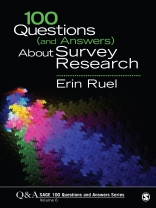Erin Ruel′s
100 Questions (and Answers) About Survey Research covers the entire survey research process, starting with developing research questions and ending with the analysis and write-up. It includes the traditional survey topics of design, sampling, question writing, and validity; includes a chapter on research ethics; covers the important topics of preparing, cleaning, and analyzing data; and ends with a section on how to write up survey results for a variety of purposes. Useful as a supplementary text in the classroom or as a reference guide for anyone starting a new survey project, the guidance is presented in a FAQ style to allow readers to jump around the book, so as to accommodate the nonlinear and iterative nature of research.
Spis treści
Preface
Acknowledgments
About the Author
Part 1: Understanding what surveys are and how they are used
1. What is a survey?
2. How are surveys used?
3. What are the benefits of doing a survey?
4. What is the survey research process from beginning to end?
5. How are good empirical research questions developed?
6. What are the various types of survey design?
7. How do we choose the right survey design?
Part 2: Addressing ethical concerns in survey research
8. What are the main ethical concerns of research?
9. If surveys are just about asking people questions, why are ethical considerations important?
10. Who ensures that research is ethical?
11. How Do IRBs Monitor Research Ethics?
12. What is the process of submitting a Survey Study to the IRB?
13. What is informed consent?
14. What Are Confidentiality and Anonymity, and How Are They Maintained?
15. What are the ethical concerns for collecting and analyzing data?
Part 3: Selecting a sample
16. Who is asked to take the survey?
17. What Is a Sample, and What Is Sampling?
18. What is a sampling frame?
19. How do we know if the sample size is large enough?
20. How does probability work?
21. What is sampling theory?
22. What is the Central Limit Theorem?
23. What is random sampling error?
24. What are the types of probability samples?
25. How is a simple random sample collected?
26. What is stratified random sampling?
27. How is a proportionate stratified probability sample collected?
28. How is a disproportionate stratified probability sample collected?
29. How do we make disproportionate stratified samples representative of the population?
30. How is a cluster sample collected?
31. How do we select a sample if the population is not easy to find?
32. What is a response rate?
Part 4: Writing good survey questions
33. What is involved in writing good survey questions?
34. How do we connect a theoretical concept to a survey question?
35. How do we write survey questions for complex theoretical concepts?
36. Do We Need to Create New Questions, or Can We Use Existing Questions?
37. What are the basic rules to writing good survey questions?
38. Are there more advanced rules to writing survey questions?
39. What are the best response options to use with survey questions?
40. What Is the Measurement Level of a Survey Question, and Why Is That Important?
41. When are open-ended questions used in survey research?
42. How do we order the survey questions?
Part 5: Establishing the reliability and validity of survey questions
43. How do we ensure our survey questions measure what they are supposed to?
44. How is content validity established?
45. What is criterion validity?
46. What is construct validity?
47. What is measurement reliability, and how is it established?
48. What is measurement error?
49. How can measurement error be minimized?
50. How Can Pretesting and Pilot Testing Improve Reliability and Validity?
Part 6: Conducting the survey
51. Once the survey is designed, how is the survey conducted?
52. How often can we contact the sample to get them to participate?
53. How are the potential members of the sample contacted?
54. How are the sample members persuaded to participate?
55. What should be included in a cover letter?
56. What other strategies can increase survey participation?
57. How do we keep track of who has and has not participated?
58. How do we conduct a longitudinal study?
59. What Other Survey Administration Issues May Arise?
60. How do we take care of survey participants?
Part 7: Entering and cleaning the data
61. Do we need to plan ahead for data entry, cleaning, and analysis?
62. My data is collected. Now what do I do?
63. How do we do data entry?
64. What issues might arise with data entry?
65. What types of survey questions are difficult to enter into the database?
66. What is a codebook, and why is it important?
67. What other sorts of documentation are needed, and why?
68. What is data cleaning?
69. How Are “Other Specify” Responses Coded?
70. How are open-ended questions coded?
Part 8: Exploring the data with univariate statistical analysis
71. What are the goals of data analysis?
72. What are variables?
73. What are descriptive statistics?
74. How do we estimate central tendency and variation in categorical and ordinal variables?
75. How do we examine central tendency in continuous variables?
76. How do we examine variation in continuous variables when using the median?
77. How do we examine variation in continuous variables when using the mean?
78. What are inferential statistics?
79. How do we infer the population parameter?
80. What is significance testing?
Part 9: Assessing associations with bivariate statistical tests and regression
81. What is meant by association between variables?
82. How do we assess an association between two continuous variables?
83. How do we determine if a correlation between two continuous variables is statistically significant?
84. How do we assess association between a categorical and a continuous variable?
85. How do we assess association between two categorical variables?
86. How do we display and report these bivariate statistics?
87. What is linear regression, and what are its benefits?
88. What is OLS regression with a continuous independent variable?
89. How do we know if the regression coefficients are statistically significant?
90. How do we interpret OLS regression with a categorical independent variable?
91. How do we interpret linear regression with more than one predictor variable?
92. How do we display and report these regression statistics?
Part 10: Writing up the analyses in report form
93. Who is my audience, and why does it matter?
94. What is a good report outline?
95. How much of the methodology needs to be included in the report?
96. What are the most important parts of the analyses to include in the report?
97. How do we report on the sample of respondents?
98. How many charts and tables should we include in the report?
99. How do we describe charts and tables in the report?
100. What is an executive summary, and why is it important?
References and Resources
Index
O autorze
Erin Ruel is associate professor of sociology and director of graduate studies at Georgia State University in Atlanta, GA. She received her Ph D in sociology at the University of Illinois at Chicago in 2003. In 2003, Erin took a postdoctoral position at the University of Wisconsin Madison in the Center for Demography of Health and Aging. While there, she continued to hone her survey research skills on the Wisconsin Longitudinal Study. Soon after arriving in Atlanta to take an assistant professor position at Georgia State University (GSU) in 2005, she began the Urban Health Initiative, a longitudinal survey study of public housing residents facing involuntary relocation with GSU colleagues. Erin was principal investigator of the National Institutes of Health study on the health outcomes of relocated public housing residents and co-investigator on two National Science Foundation grants, examining social disorganization and social support for public housing residents. She employs quantitative and mixed methods to examine health disparities and the health consequences of racial residential segregation, neighborhood disadvantage, housing, and socioeconomic status. Ruel has published in numerous journals, including Demography, Social Forces, Social Science Research, Health and Place, Journal of Housing Studies, Cities, Sociology Compass, Journal of Adolescent Health, and Journal of Urban Health.












